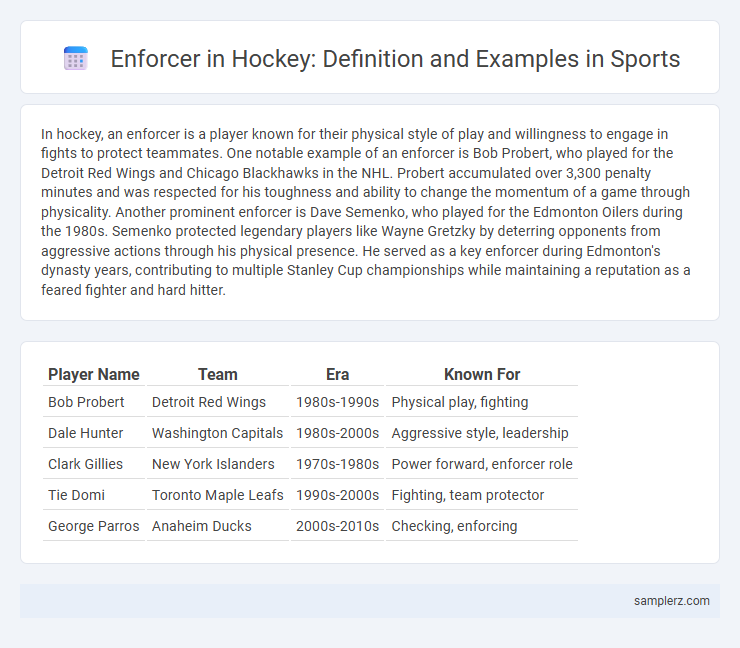In hockey, an enforcer is a player known for their physical style of play and willingness to engage in fights to protect teammates. One notable example of an enforcer is Bob Probert, who played for the Detroit Red Wings and Chicago Blackhawks in the NHL. Probert accumulated over 3,300 penalty minutes and was respected for his toughness and ability to change the momentum of a game through physicality. Another prominent enforcer is Dave Semenko, who played for the Edmonton Oilers during the 1980s. Semenko protected legendary players like Wayne Gretzky by deterring opponents from aggressive actions through his physical presence. He served as a key enforcer during Edmonton's dynasty years, contributing to multiple Stanley Cup championships while maintaining a reputation as a feared fighter and hard hitter.
Table of Comparison
| Player Name | Team | Era | Known For |
|---|---|---|---|
| Bob Probert | Detroit Red Wings | 1980s-1990s | Physical play, fighting |
| Dale Hunter | Washington Capitals | 1980s-2000s | Aggressive style, leadership |
| Clark Gillies | New York Islanders | 1970s-1980s | Power forward, enforcer role |
| Tie Domi | Toronto Maple Leafs | 1990s-2000s | Fighting, team protector |
| George Parros | Anaheim Ducks | 2000s-2010s | Checking, enforcing |
Definition of an Enforcer in Hockey
An enforcer in hockey is a player known for their physicality and role in protecting teammates by engaging in fights and intimidating opponents. They serve as a deterrent to aggressive play against skill players, often leading to increased team safety and morale. Enforcers typically accumulate high penalty minutes due to their frequent involvement in on-ice altercations and physical confrontations.
Historical Evolution of the Hockey Enforcer
The role of the hockey enforcer evolved from the early 20th century when players like Eddie Shore established the enforcer tradition by combining physicality with skill. During the 1970s and 1980s, figures such as Bob Probert and Dave Semenko became iconic enforcers, embodying the protective presence and intimidation tactics essential to their teams. The modern game has seen a decline in enforcers, replaced by players who combine physical play with speed and skill, reflecting changes in rules and player safety standards.
Notable NHL Enforcers Through the Decades
Notable NHL enforcers such as Bob Probert in the 1980s and 1990s, Dave Semenko in the 1970s and 1980s, and Tie Domi in the 1990s and early 2000s have left a lasting impact on hockey history. These players were renowned for their physicality, willingness to fight, and protecting star teammates, solidifying their role as protectors on the ice. The enforcer position has evolved but remains a key component of team dynamics in the NHL across decades.
Role of Enforcers in Team Dynamics
Enforcers in hockey serve as physical deterrents, protecting star players and maintaining team toughness by engaging in fights and delivering punishing hits. Their presence shifts momentum and intimidates opponents, crucial for upholding team morale and cohesion during high-stakes games. By enforcing unwritten rules on the ice, enforcers contribute strategically to overall team dynamics and competitive balance.
Famous Hockey Fights Involving Enforcers
Famous hockey fights involving enforcers have shaped the sport's intense physicality, with players like Bob Probert and Dave Semenko standing out for their roles in protecting teammates and intimidating opponents. Probert's confrontations, especially during the Detroit Red Wings era, exemplify legendary battles that energized crowds and shifted game momentum. Semenko's reputation as Wayne Gretzky's bodyguard on the Edmonton Oilers highlights how enforcers combined skill and toughness to maintain team dominance.
The Decline of Enforcers in Modern Hockey
The role of enforcers, once pivotal in maintaining on-ice intimidation and team protection, has significantly declined in modern hockey due to rule changes and an increased emphasis on speed and skill. Players like Bob Probert and Tiger Williams exemplified the traditional enforcer's physicality, but today's NHL prioritizes discipline and reduced fighting, reducing the demand for dedicated enforcers. This shift has led teams to favor versatile athletes who can contribute offensively and defensively rather than solely serve as physical enforcers.
Enforcer Impact on Game Strategy
Enforcers in hockey, such as Dave Schultz or Bob Probert, significantly influence game strategy by intimidating opponents and protecting star players, which creates space for skilled teammates to operate more freely. Their presence deters detrimental physical play, shifting the opposition's tactical approach to a less aggressive style. Teams often adjust line matchups and penalty kill strategies to accommodate the enforcer's role, optimizing both offensive opportunities and defensive stability.
Legendary Enforcer Duos and Rivalries
The legendary enforcer duo of Bob Probert and Tiger Williams became iconic for their physicality and intimidation on the ice, setting the tone for their teams during intense NHL battles. Rivalries between enforcer pairs such as Clark Gillies and Dale Hunter fueled some of the most memorable and hard-fought matchups in hockey history, emphasizing the role of toughness and protection in the sport. These enforcer rivalries not only shaped team dynamics but also elevated the excitement and drama surrounding key playoff series and regular-season clashes.
Player Safety and the Future of Enforcers
Enforcers in hockey play a pivotal role in maintaining player safety by deterring aggressive behavior and protecting teammates, which contributes to the sport's physical integrity. The evolving landscape of hockey emphasizes skill and speed, prompting a shift in the enforcer role towards disciplined physical play and concussion prevention. Advancements in player safety protocols and equipment technology are shaping the future of enforcers, integrating toughness with a greater focus on health and career longevity.
Enforcers’ Legacy in Hockey Culture
Enforcers like Bob Probert and Tiger Williams have left a lasting legacy in hockey culture, defining the gritty toughness and protective role that shaped the sport's identity. Their presence altered game dynamics, deterring cheap shots and fostering team solidarity, while also sparking debates about violence and sportsmanship. This legacy continues to influence player roles and NHL regulations, balancing physicality with skill to preserve hockey's intense yet respectful spirit.

example of enforcer in hockey Infographic
 samplerz.com
samplerz.com